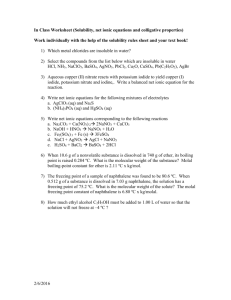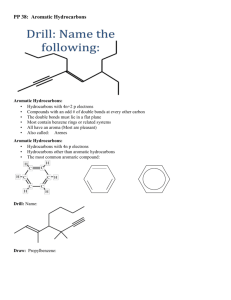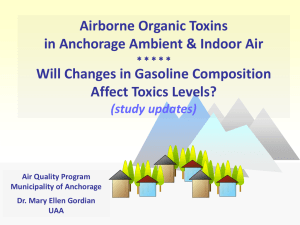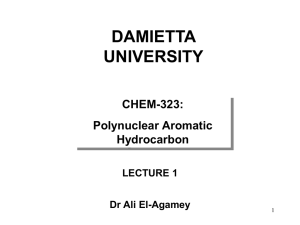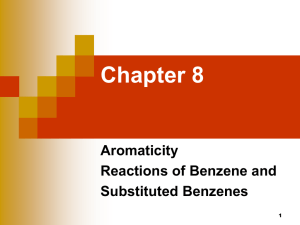GEAC_A_436124_O 1412..1424
advertisement
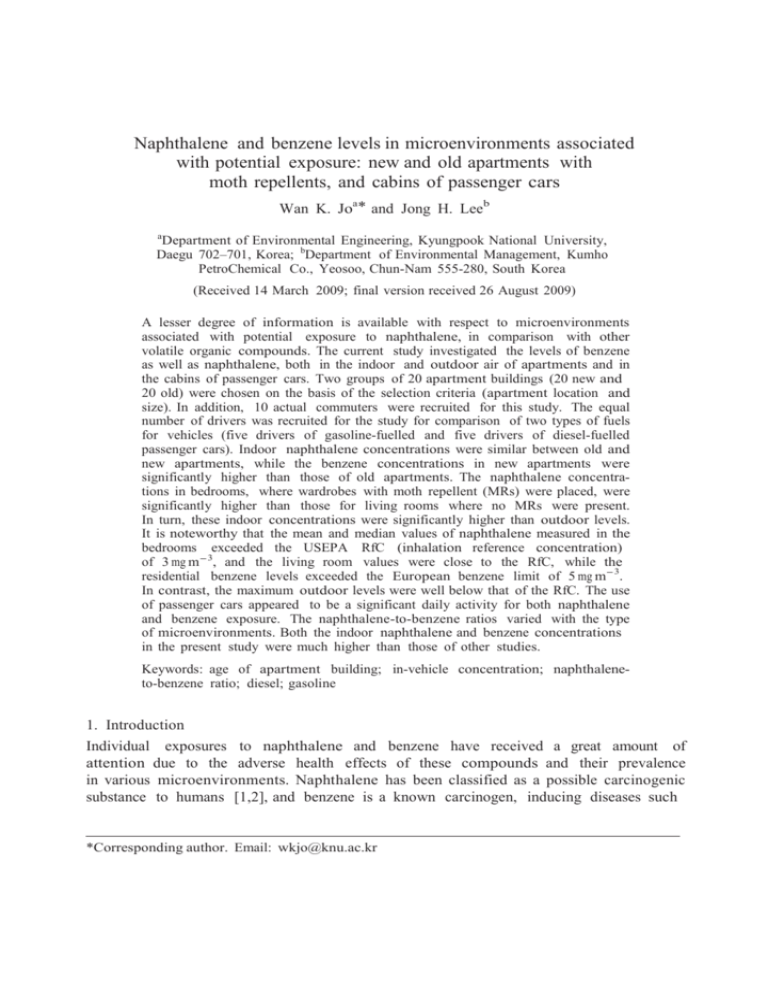
Naphthalene and benzene levels in microenvironments associated with potential exposure: new and old apartments with moth repellents, and cabins of passenger cars Wan K. Joa* and Jong H. Leeb a Department of Environmental Engineering, Kyungpook National University, Daegu 702–701, Korea; bDepartment of Environmental Management, Kumho PetroChemical Co., Yeosoo, Chun-Nam 555-280, South Korea (Received 14 March 2009; final version received 26 August 2009) A lesser degree of information is available with respect to microenvironments associated with potential exposure to naphthalene, in comparison with other volatile organic compounds. The current study investigated the levels of benzene as well as naphthalene, both in the indoor and outdoor air of apartments and in the cabins of passenger cars. Two groups of 20 apartment buildings (20 new and 20 old) were chosen on the basis of the selection criteria (apartment location and size). In addition, 10 actual commuters were recruited for this study. The equal number of drivers was recruited for the study for comparison of two types of fuels for vehicles (five drivers of gasoline-fuelled and five drivers of diesel-fuelled passenger cars). Indoor naphthalene concentrations were similar between old and new apartments, while the benzene concentrations in new apartments were significantly higher than those of old apartments. The naphthalene concentrations in bedrooms, where wardrobes with moth repellent (MRs) were placed, were significantly higher than those for living rooms where no MRs were present. In turn, these indoor concentrations were significantly higher than outdoor levels. It is noteworthy that the mean and median values of naphthalene measured in the bedrooms exceeded the USEPA RfC (inhalation reference concentration) of 3 mg m-3, and the living room values were close to the RfC, while the residential benzene levels exceeded the European benzene limit of 5 mg m-3. In contrast, the maximum outdoor levels were well below that of the RfC. The use of passenger cars appeared to be a significant daily activity for both naphthalene and benzene exposure. The naphthalene-to-benzene ratios varied with the type of microenvironments. Both the indoor naphthalene and benzene concentrations in the present study were much higher than those of other studies. Keywords: age of apartment building; in-vehicle concentration; naphthaleneto-benzene ratio; diesel; gasoline 1. Introduction Individual exposures to naphthalene and benzene have received a great amount of attention due to the adverse health effects of these compounds and their prevalence in various microenvironments. Naphthalene has been classified as a possible carcinogenic substance to humans [1,2], and benzene is a known carcinogen, inducing diseases such *Corresponding author. Email: wkjo@knu.ac.kr 2 as leukemia [1]. Homes are an important indoor microenvironment for potential exposure to these hazardous/toxic compounds. Naphthalene is the most abundant polycyclic aromatic hydrocarbon (PAH) found in typical urban air [3]. Benzene is one of several monocyclic aromatic hydrocarbons which may be detected at high concentration levels in both indoor and outdoor environments [4,5]. Several researchers have also reported that naphthalene and benzene levels in urban air were higher than those of rural or suburban air [3,4, 6–9]. These elevated urban air levels have been directly linked to various urban sources such as industrial discharges and the burning of fossil fuels [3,4,10,11]. Atmospheric naphthalene can penetrate indoors, thereby elevating the indoor concentration levels [12]. In addition, indoor naphthalene and benzene levels have been proven to be further elevated by various indoor sources, such as consumer products, cigarette smoke and/or building materials [3,5,6,13]. 2. Experimental 2.1 Study protocol The current study measured the concentrations of naphthalene and benzene, both in the indoor and outdoor air of apartment spaces and in the cabins of passenger cars in the city of Daegu, between 6 November 2006 and 13 April 2007. Two groups of 20 apartment buildings (20 new and 20 old) were chosen. The age of the apartments was determined based on the completion date of apartment construction: New apartments are less than six months old after completion of construction (ages, 2 and 5.5 months) and old apartments are between 12 and 18 months old. Since VOC emissions from new residential buildings usually reach peak values within six months, Table 1. Information on gasoline-fuelled and diesel-fuelled passenger cars surveyed in the current study. Fuel Gasoline Diesel Identification number (ID) Manufacturing company Engine size (cc) Model year Odometer reading (km) 1 2 3 4 5 A B B B B 1800 1800 1600 2000 3500 1998 1996 2006 1998 2003 165,352 181,105 9,371 198,766 75,335 6 7 8 9 10 C D C B B 2500 2500 2000 2000 2000 2005 1999 2005 2005 2003 43,163 173,310 38,778 47,325 97,443 of this experiment were asked not to smoke during the sampling procedures. In addition, there were no previous smoking activities in the survey vehicles. The morning and evening commutes consisted of the first and the second vehicle use of the sampling days, respectively, for all drivers. 2.2 Sampling and analytical methods Tenax adsorbents (Tenax TA 60/80, Supelco Co.) were utilised for naphthalene and benzene samples [11]. A constant-flow sampling pump (Aircheck Sampler Model 224-PCXR8, SKC Inc.) was connected to a 1/400 stainless steel trap containing 0.2 g of a Tenax TA adsorbent. The sampling pump was calibrated by a mass flow meter, prior to and following the 1423 4. Conclusion The present study investigated naphthalene levels, in conjunction with benzene levels, in two major microenvironments (indoor and outdoor air of apartments with MRs, and cabins of passenger cars) potentially associated with elevated exposure levels. Although the bedroom naphthalene concentrations observed from homes that utilised paper-type MRs were lower than those from homes that utilised ball-type MRs, the concentrations were higher than RfC (3 mg m-3). Therefore, recognising the proportion of time people typically spend in residential indoor environments, the use of MRs is a significant source of personal exposure to naphthalene regardless of the types (especially exposure during the time of sleeping in bedroom). Our results also suggest that commuting inside passenger cars is a daily activity significantly contributing to both naphthalene and benzene exposure levels. Moreover, it is noteworthy that the residential benzene levels, even in old apartments, exceeded the European limit of 5 mg m-3. Acknowledgements This study could not have been accomplished without the cooperation of 10 car drivers and the residents of the 40 surveyed apartments. The authors would like to thank three graduate students (Mr. C.H. Yang, Mr. J.T. Kim and Miss. M.H. Shin) in the Department of Environmental Engineering, Kyungpook National University, for their sample collecting and/or analyses. We wish to thank the reviewers for their thoughtful corrections and valuable suggestions regarding our paper. This work was supported by the Korea Science and Engineering Foundation (KOSEF) grant funded by the Korea government (MOST) (No. R01-2006-000-10851-0). References [1] IARC (International Agency for Research on Cancer), Monographs on the Evaluation of Carconogenic Risks to Humans, Vol. 82 (IARC, Lyon, France, 2002), p. 36 [2] USEPA (United States Environmental Protection Agency), Health Effects Support Document for Naphthalene, EPA 822-R-03-005 (Office of Water, Health and Ecological Criteria Division, Washington DC, 2003). Available online at http://epa.gov/safewater/ccl/pdf/naphthalene.pdf [3] A. Li, T.M. Schoonover, Q. Zou, F. Norlock, L.M. Conroy, P.A. Scheff, and R.A. Wadden, Atmos. Environ. 39, 3491 (2005). [4] B. Buzcu and M.P. Fraser, Atmos. Environ. 40, 2385 (2006). [5] C. Jia, S. Batterman, and C. Godwin, Atmos. Environ. 42, 2083 (2008). [6] M.R. Van Winkle and P.A. Scheff, Indoor Air 11, 49 (2001). [7] R. Preuss, J. Angerer, and H. Drexler, Int. Arch. Occ. Env. Hea. 76, 556 (2003). [8] S.G. Brown, A. Frankel, and H.R. Hafner, Atmos. Environ. 41, 227 (2007). [9] J. Hoshi, S. Amano, Y. Sasaki, and T. Korenaga, Atmos. Environ. 42, 2383 (2008).

